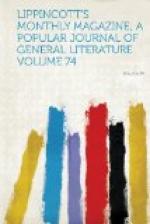With this excellent analysis before us, we will recall one by one some of the best-known and most interesting works of W.M. Hunt, a painter who now holds a prominent place among the artists of America. We will try to discover by careful observation if the high gifts of Verity and Imagination, the sign and seal of the true artist, really belong to him: if so, where these qualities are expressed, and what value we should set upon them.
First, perhaps, for those readers remote from New England who may never have seen any pictures by this artist, a few words should be said by way of describing some characteristics of his work and the limitations of it; which limitations are rather loudly dwelt upon by connoisseurs and lovers of the popular modern French school. Artists discern these limitations of course more keenly even than others, but their tribute to verity and ideal beauty as represented by this painter is too sincere to allow caviling to find expression. This limitation to which we refer causes Mr. Hunt to allow ideal suggestions, rather than pictures, to pass from his studio, and makes him cowardly before his own work. It recalls in a contrary sense that saying of the sculptor Puget: “The marble trembles before me.” Mr. Hunt trembles before his new-born idea. His swift nature has allowed him in the first hour of work to put into his picture the tenderness or rapture, the unconscious grace or tempestuous force, which he despaired at first of ever being able to express. In the flush of success he stops: he has it, the idea; the chief interest of the subject is portrayed before him; the delicate presence (and what can be more delicate than the thoughts he has delineated?) is there, and may vanish if touched in a less fortunate moment. But is this lack of fulfillment in the artist entirely without precedent or parallel? Had not Sir Joshua Reynolds a studio full of young artists who “finished off” his pictures? Were not the very faces themselves painted with such rapidity and want of proper method as to drop off, on occasion, entirely from the canvas, as in case of the boy’s head, in being carried through the street? Hunt is of our own age, and would scorn the suggestion of having a hand or a foot painted for him, as if it were a matter of small importance what individual expression a hand or a foot should wear; but who can tell for what future age he has painted the wise, abrupt, kind, persistent, simple, strong old Judge in his Yankee coat; or the genial, resolute, hopeful, self-sacrificing governor of Massachusetts; and the Master of the boys, with his keen, loving, uncompromising face? These are pictures that, when children say, “Tell us about the Governor who helped Massachusetts bring her men first into the field during our war,” we may lead them up before and reply, “He was this man!” So also with the portraits of the Judge, of the Master of the boys, of the old man with clear eyes and firm mouth, and that sweet American girl standing, unconscious of observation, plucking at the daisy in her hat and guessing at her fate.




